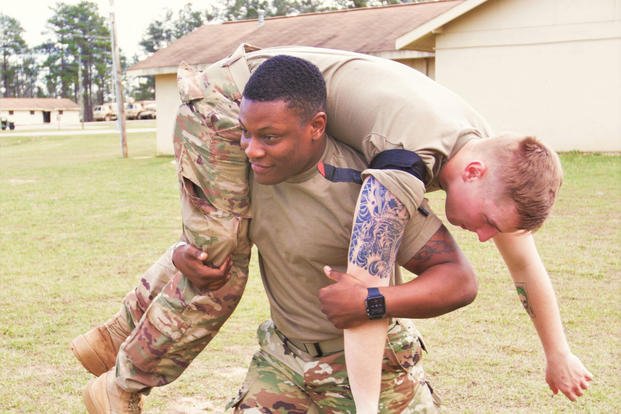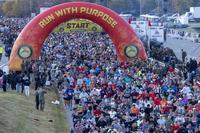I was recently asked by an Army veteran whether there were other fitness tests out there to challenge people who want to be tactically fit. This particular veteran likes to stay as fit as he was while serving more than 10 years ago and still manages an above-average Army physical fitness test for age groups 20 years younger.
These are great health and fitness goals to ace a basic physical fitness test (PFT), but is it really a tactical fitness test? No. See the multiple dimensions required in creating a foundation to be "tactically fit" in order to have the ability to perform some of the most dangerous jobs in the world, defending and protecting our country and communities.
Tactical fitness is the new fitness genre that I define as the ability to perform military, police and firefighter job-related skills, such as running, rucking, swimming, buddy rescue and equipment carry. Those skills require upper- and lower-body strength and muscle endurance.
I have been wanting to make an all-inclusive tactical fitness test for a while now. The test below has no scientific study behind it; these are simply my opinions about what tactical athletes should be able to do. However, all these events are commonly used testing events used by many military, special-ops teams, SWAT teams, police and firefighters.
These are the 12 events I call the Tactical Fitness Dirty Dozen. There is a grading system that is quite generous in basic pass/fail standards, as well as a max point system of 100 points.
The events justification:
25-pound pull-up: Weighted pull-ups are required. The most gear a tactical operator wears will weigh anywhere from 15-25 pounds, minus the backpack. The minimum is two reps; the max is 10 reps. One point for each rep for a total of 2-10 points.
Body-weight bench press: Upper-body strength with a combination of moving your body weight for multiple repetitions to test the pushing power of the tactical athlete. The minimum points are for five reps (two points), and the maximum (10 points) is for 15 reps.
Deadlift (1.5x body weight): Can you lift more than your own body weight? Practicing this event alone will help a tactical athlete learn proper lifting techniques and build a stronger foundation to move heavy weight when required. One rep is pass/fail, but two points per rep until five reps for more points. The minimum points for two reps (one point) and maximum (10) for five reps.
Fireman carry: Can you rescue your buddy and carry for 100 yards? Pass/fail criteria (five points for passing)
400-meter sprint: Can you run fast (no gear)? Sixty seconds for max points/80 seconds for the minimum standard. Sometimes speed is essential. Minimum points for 80 seconds (one point) and maximum (10) for 60 seconds.
300-yard shuttle run: Can you run back and forth quickly (6 x 50-meter shuttle)? Sixty seconds max/80 seconds minimum standard.
Minimum points for 80 seconds: one point. Maximum for 60 seconds: 10 points.
Illinois agility test: You will have to zig and zag while running at full speed, changing direction often. Max points (five) if completed under 15 seconds. Deduct a point for every second slower than 15 seconds until 19 seconds (one point). Slower than 19 seconds = fail.
Plank pose: Can you hold the plank pose for a minimum of one minute? Get extra points for every minute after that and max out at five minutes. One point, one minute. Add a point for each minute up to five minutes. Max points: five points.
3-mile timed run: Can you run three miles without stopping? Then you pass. If you get 18 minutes, you max the test and can pick up a few more points if you can keep it under 23 minutes. Ten points for 18 minutes, one point less for every 30 seconds until the minimum point time of 23 minutes.
50-pound ruck in under 1 hour (4 miles): This is the minimum standard for Army rucking times. Can you pace yourself at a perfect 15-minute mile with a 50-pound backpack or weight vest? No need to go too fast on this event. It is about finishing at a steady pace. No extra points for getting under one hour. Ten points, pass or fail.
Swim: Can you swim? If you cannot swim, you are ineffective on 75% of this planet. Be an asset to your team, yourself and your family. This is a basic survival skill we should know how to do. Five points for just knowing how to swim.
500-meter swim: Any stroke. Swim 500 meters nonstop, and you pass. Get 500 meters in six minutes or less and max out the swim test. You can get extra points until the 11th minute. Five points for maxing the swim, one point less for every minute until the 10th minute.
25-meter lifesaving buddy tow: Can you dive to the bottom of a pool (8-9 feet), grab an unconscious buddy and tow him 25 meters to the other end of the pool? Pass or fail -- five points.
Here is a chart to make it easier to understand:
|
Exercise |
Pass/Fail Criteria |
|
4-mile ruck (50 pounds) |
1 hour maximum time |
|
25-pound pull-up max reps |
2-10 reps |
|
Bench press (body weight) |
Pass or fail -- 1 rep; 5-15 reps for extra points |
|
Deadlift (1.5x body weight) |
Pass or fail -- 1 rep; 2-5 reps for extra points |
|
Fireman carry (P/F) |
100 yards of equal body weight |
|
400-meter sprint |
60-80 seconds |
|
Shuttle run 300 yards |
60-80 seconds |
|
Plank pose (P/F) |
1 minute minimum/5 minute max |
|
3-mile run (P/F) |
18 minutes to 23 minutes for extra points |
|
IL agility test |
<15 secs to >19 sec |
|
Swim -- can you swim? (P/F) |
Yes/no |
|
Swim 500 meters timed |
6-11 minutes |
|
Swim (buddy tow) |
Pass/fail -- 25-meter rescue swim |
The max points is 100 points if you ace everything. You still can pass with as little as 40 points. You must pass all events to pass the test. Give it a try and see where you stand. Practice your weaknesses and think your way through this test.
The interesting thing about this test is that you can arrange the events in any order you wish. Get creative and develop your own strategy for better performance. The test can be broken up into two sessions or challenge yourself and go for all events in one long testing session.
Stew Smith is a former Navy SEAL and fitness author certified as a Strength and Conditioning Specialist (CSCS) with the National Strength and Conditioning Association. Visit his Fitness eBook store if you're looking to start a workout program to create a healthy lifestyle. Send your fitness questions to stew@stewsmith.com.
Want to Learn More About Military Life?
Whether you're thinking of joining the military, looking for fitness and basic training tips, or keeping up with military life and benefits, Military.com has you covered. Subscribe to Military.com to have military news, updates and resources delivered directly to your inbox.



















